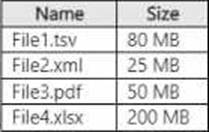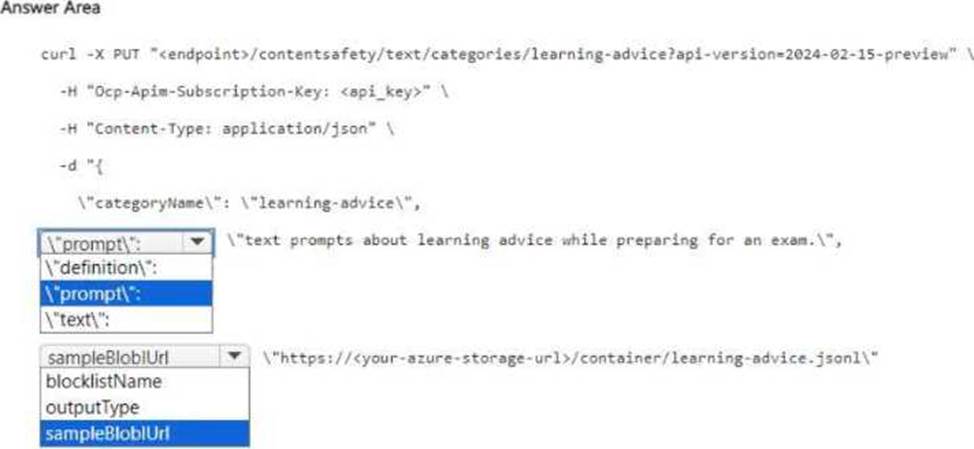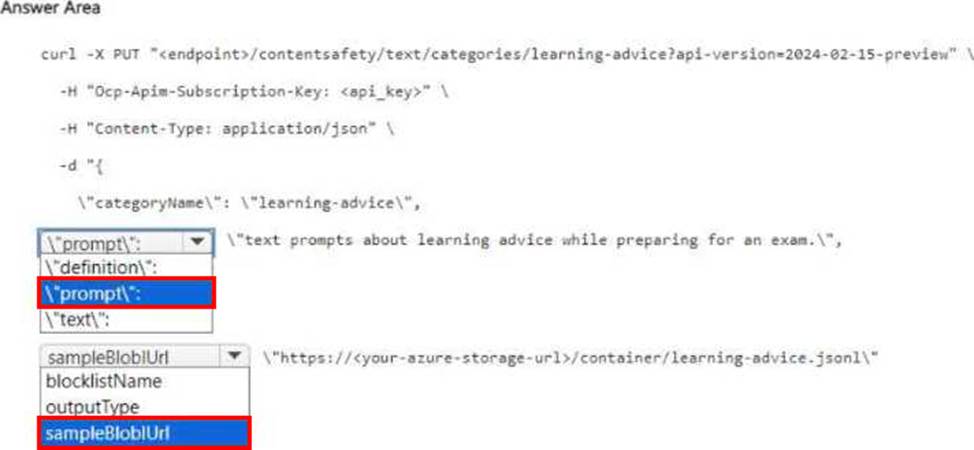Practice Free AI-102 Exam Online Questions
You have a custom Azure OpenAI model.
You have the files shown in the following table.

You need to prepare training data for the model by using the OpenAI CLI data preparation tool.
Which files can you upload to the tool?
- A . Filel.tsvonly
- B . File2.xml only
- C . File3.pdf only
- D . File4.xlsx only
- E . File1.tsv and File4.xslx only
- F . File1.tsv.File2.xml and File4.xslx only
- G . File1.tsv, File2.xml, Fil3.pdf and File4.xslx
HOTSPOT
You have an Azure subscription that contains an Azure Al Content Safety resource named resource1.
You need to add a custom category to resource1.
How should you complete the cURL statement? To answer, select the appropriate options in the answer area. NOTE: Each correct selection is worth one point.


You are building a natural language model.
You need to enable active learning.
What should you do?
- A . Add show-all-intents=true to the prediction endpoint query.
- B . Enable speech priming.
- C . Add log=true to the prediction endpoint query.
- D . Enable sentiment analysis.
C
Explanation:
Reference: https://docs.microsoft.com/en-us/azure/cognitive-services/luis/luis-how-to-review-endpoint-utterances#log-user-queries-to-enable-active-learning
You have an Azure loT hub that receives series data from machinery.
You need to build an app that will perform the following actions:
• Perform anomaly detection across multiple correlated sensors
• Identify the root cause of process stops.
• Send incident alerts
The solution must minimize development time.
Which Azure service should you use?
- A . Azure Metrics Advisor
- B . Form Recognizer
- C . Azure Machine teaming
- D . Anomaly Detector
What is a characteristic of a non-relational database?
- A . full support for Transact-SGL
- B . a fixed schema
- C . self describing entities
You have an Azure subscription that contains an Azure Al Document Intelligence resource named DM. DI1 uses the Standard SO pricing tier
You have the files shown in the following table.

Which files can you analyze by using DI1?
- A . File1.pdf only
- B . File2.jpg only
- C . File3 tiff only
- D . File2.jpg and File3.tiff only
- E . File1.pdf, File2, jpg, and File3, tiff
You have a 20-GB file named file1, avi that is stored on a local drive.
You need to index file1, avi by using the Azure Video indexer website.
What should you do first?
- A . Upload File1 avi to an Azure storage queue.
- B . upload File1.avi to the www.youtube.com seepage
- C . Upload file1 avi to the Azure video indexer website.
- D . Upload file1 avi to Microsoft OneDrive.
D
Explanation:
This is because the Azure Video Indexer website allows you to upload videos from a URL or from your file system, but there are some limitations and considerations for each option1.
If you upload from your file system, the size of the file is limited to 2 GB, which is less than the size of file1.avi (20 GB). Therefore, this option is not feasible.
If you upload from a URL, the size of the file is limited to 30 GB, which is enough for file1.avi. However, the URL must be publicly accessible and valid, and the file must be accessible. You cannot use URLs from streaming services such as YouTube1. Therefore, options A and B are not valid.
The best option is to upload file1.avi to a cloud storage service such as Microsoft OneDrive, and then generate a shareable link for the file. You can then paste the link in the Azure Video Indexer website and upload the video from the URL. This way, you can avoid the file size limitation and ensure that the file is accessible and valid2.
You have data saved in the following format.
![]()
Which format was used?
- A . CSV
- B . JSON
- C . HTML
- D . YAML
You are building a multilingual chatbot.
You need to send a different answer for positive and negative messages.
Which two Text Analytics APIs should you use? Each correct answer presents part of the solution. NOTE: Each correct selection is worth one point. (Choose two.)
- A . Linked entities from a well-known knowledge base
- B . Sentiment Analysis
- C . Key Phrases
- D . Detect Language
- E . Named Entity Recognition
BD
Explanation:
B: The Text Analytics API’s Sentiment Analysis feature provides two ways for detecting positive and negative sentiment. If you send a Sentiment Analysis request, the API will return sentiment labels (such as "negative", "neutral" and "positive") and confidence scores at the sentence and document-level.
D: The Language Detection feature of the Azure Text Analytics REST API evaluates text input for each document and returns language identifiers with a score that indicates the strength of the analysis. This capability is useful for content stores that collect arbitrary text, where language is unknown.
Reference: https://docs.microsoft.com/en-us/azure/cognitive-services/text-analytics/how-tos/text-analytics-how-to-sentiment-analysis?tabs=version-3-1
https://docs.microsoft.com/en-us/azure/cognitive-services/text-analytics/how-tos/text-analytics-how-to-language-detection
You develop a custom question answering project in Azure Cognitive Service for Language. The project will be used by a chatbot. You need to configure the project to engage in multi-turn conversations.
What should you do?
- A . Add follow-up prompts.
- B . Enable active learning.
- C . Add alternate questions.
- D . Enable chit-chat.
